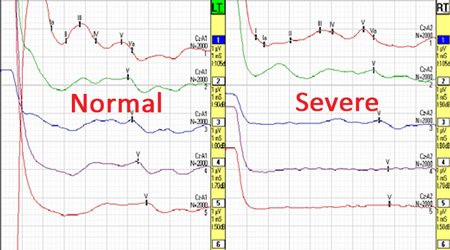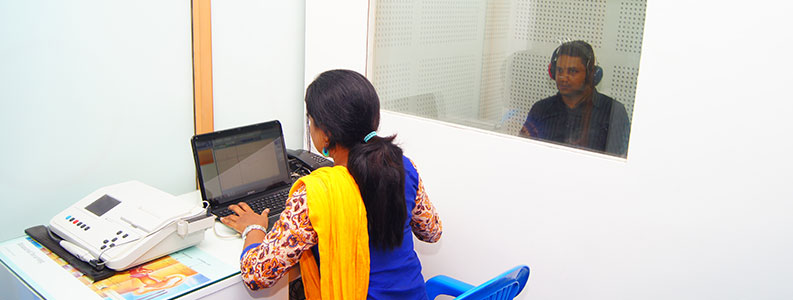Audiology Services
A thorough and accurate hearing evaluation is the precursor to efficient management of the hearing impaired. The competence of the audiology department and the result given play an important role to achieve the same. Our department is well equipped and manned by competent well trained staff. To ensure accuracy, most of the reports are rechecked. The equipments are also calibrated regularly.
In addition to providing treatment support to our patient our audiology department also offers diagnostic support to Doctors and audiologists by doing the tests and giving the test report of their referred patients
Therapeutic [Treatment]
This facility is offered to our entire patients. The audiologist after evaluation draws specific and individualized recommendations in each case in consultation with the ENT Specialist. A treatment plan is laid down and followed. We also request our patients to follow each recommended step meticulously to help you achieve the best possible results. Treatment changes if needed are made during follow up with active participation of all active participants. Some treatments offered are
Hearing Aid Prescription / Fitting
Hearing aids are not “one size fit all”. They have to be evaluated, prescribed and fitted to every individual need. To buy a hearing aid without appropriate fitting is not a wise decision and hence not recommended. At Shravan “Your hearing health is our concern!”
Hearing aid technology has made significant changes over the past several years and continues to evolve. Anyone can sell you a hearing aid, but to prescribe and fit a hearing aid successfully is a complex technical procedure. Only an ENT specialist or an Audiologist who is trained for hearing aid technology and fitting should prescribe hearing aids to a patient.
In Shravan, we provide a 3 tiered system consisting of an ENT specialist, Clinical Audiologist and Hearing Aid Retailer services, under one roof. This helps us in better coordination. We will help you through the fitting process and provide the advanced technology hearing aids. By using appropriated fitting method we allow our patients to achieve their fullest communication potential and improve your quality of life. Visit us today!
Read more
AVT [Auditory Verbal Therapy].
Hearing Aid fitting has definitely opened a new world of opportunity for the hearing impaired. In case of children just fitting a hearing aid does not end our responsibility. It takes a while for the child to make sense of the sounds they hear through hearing aids. A comprehensive training program is necessary to help the child learn language through listening. This training process is AVT. With proper AVT your child will develop language and speak verbal.
Our Auditory verbal therapist will do a detail assessment of the listening and language skills of the child. After the assessment an individualist AVT plan will be laid down. Auditory verbal therapy is an individualised, auditory, developmental programme, implemented by the child’s family in close collaboration with the therapist who will guide and teach the parents to apply the techniques unique to each child. Our goal is to achieving age appropriate spoken language ability, and social participation throughout childhood and beyond.
Tinnitus management
Tinnitus refers to “ringing / noise in the ears”. Tinnitus can sound like hissing, roaring, pulsating, whooshing, chirping, whistling or clicking. It can occur in one or both ear. They are very annoying, can cause communication and sleep difficulty.
The most effective treatment for tinnitus is to eliminate the underlying cause. To treat the same you will be first seen by our ENT specialist who will identify treatable condition and treat you to relieve you of your tinnitus.
Unfortunately, in many cases, the cause of tinnitus cannot be identified, or medical or surgical treatment is not an option. In these cases, patients can still be offered relief by a variety of other methods. In case of non treatable tinnitus our audiologist will help you to achieve relief / comfort. If you have a hearing loss in addition, there is a good chance that a hearing aid with tinnitus masker will help relieve your tinnitus and help you hear. Kindly keep in mind a treatment that is useful and successful for one person may not be appropriate for another.
Diagnostic [Tests]
Much energy is spent by the majority in treating the symptoms. The same enthusiasm should be shown to correct diagnosis too. If you treat the symptoms you will best get temporary relief, but if you treat the cause you get rid of the problem. In Shravan we take extra care during the diagnostic process.
Our mission is to provide high quality, comprehensive hearing healthcare to the community. To help other patients we offer these diagnostic facilities to patients referred by Doctors and Audiologist who do not have the facilities in there clinic. We have multiple tests both Subjective and Objective, which help us to evaluate all age groups, from new born to the geriatric. This helps a long way to these patients get correct treatment. Some diagnostic tests available are.
Audiogram Pure Tone [PTA].
Treatment success is directly dependent on the test quality result. Fine touch audiometer, regularly calibrated, a reasonably sound proof room and a competent empathetic audiologist, with ample patience is a must to achieve a good audiogram. Since PTA is a subjective test the same is possible only with a cooperative patient.
In a cooperative patient PTA or Pure tone audiometry is the most reliable and the basic test used to determine the presence or absence of hearing loss with respect to type, degree, and pattern. The graph with hearing loss and frequency in the two axis’s is called an audiogram. The test usually takes 20 to 30 minutes.
PTA Special Tests
In some situation we have to utilize PTA special tests to come to a more definitive diagnosis. Like we use SiSi / Tone decay test to differential cochlear from retro cochlear pathology. MCL / UCL parameters go a long way to help achieve a good fit in hearing aid prescription. Some of the special PTA test done in our centre are
SiSi [Short increment Sensitivity index] Test
This test is based on the phenomenon known as recruitment (Abnormal loudness growth). The test is widely used to determine the patient with cochlear pathology. Jerger clearly demonstrated that the ability to detect the 1 dB increments was restricted to patients with cochlear pathology.
Tone Decay Test
This test is utilized to detect and measure auditory fatigue which is usually seen in nerve disease. The patient is asked to respond as long as he hears a 60 second sound stimulus. Depending on the response the audiologist will be able to rule out retro cochlear pathology [Nerve lesions like Acoustic Neuroma].
MCL / UCL
During this test procedure patient’s comfortable and uncomfortable loudness tolerance level is determined. This test would help us understand the dynamic range of the patient. It is especially useful during the fitting of hearing aid as the output of the hearing aid would be set such that the output of the hearing aid would be well within the dynamic range, to help the patient listen comfortably.
Impedance Audiometry [Immitance Test]
Impedance study is done to study the integrity of the middle ear. It is a quick, painless, objective test and hence very useful in infants and children. Subtle controlled air pressure and a tone is presented in the ear canal through a soft tip probe. The display shows reading as a graph. Always ensure the ear canal is clean of all debris including wax as a little casualness will lead to wrong results. Some of the usually done impedance tests are
Tympanogram
Tympanometry is a testing methodology, used to evaluate the function of the middle ear structures. It provides a graphic representation of the relationship of air pressure in the EAC to impedance of the ear drum and Middle ear system. This graph is called the tympanogram. Typical test time for both ears is less than two minutes. It is very useful test to diagnose SOM [Secretory Otitis Media].
Eustachian tube function test
The Eustachian tube runs from the throat to the middle ear. The purpose of the Eustachian tube is to equalize the pressure in your middle ear with the atmospheric pressure. Dysfunction of Eustachian is the commonest cause of middle ear pathology. This test help us study the functional efficiency of the Eustachian tube which should be a mandatory test before treating any chronic middle ear disease.
SRT [Acoustic Reflex Threshold] Test
Measure the stapedial muscle's response to higher intensity at specific frequencies involving the cochlea (organ of hearing) and the auditory pathway within the brainstem. This reflex is received as a reflex graph and studied. This test is very useful to find out early hearing loss in non cooperative and malingering patients.
ABR [Auditory Brainstem Response] test or BERA[Brainstem Evoked Response Audiometry]
BERA is a very reliable objective test for hearing. This test is non-invasive and the procedure is performed while the patient is lying down. It can be done in a semi sound proof room also. The patient is required to be still and quiet throughout the test, therefore some infants and small children may require sedation. The test usually takes 30 min to 1 hr, excluding the time taken for sedation. The BERA test is used for two purposes.
Threshold BERA [Hearing evaluation]:
This test is typically utilized by the ENT specialist and the Audiologist to confirm and quantify hearing loss, in children and in those adults when PTA test is not reliable. After electrode placement, sound stimuli from 30 dB to 110 dB are given and the BERA waves obtained. The ENT specialist and audiologist will analyze the recordings and give the test result report. These test results of hearing loss are of reasonable level. These parameters are very helpful for good hearing aid fitting in children.

Routine BERA
BERA test was designed to test the integrity of the 8th nerve. In this test auditory inputs at 105 dB are given multiple times and the wave studied to detect the site of lesion [Acoustic Neuroma] / status of the nerve [In degenerative diseases etc]. Routine BERA is usually advised and done by the neurologist unlike threshold BERA which is advised by ENT / Audiologist.

